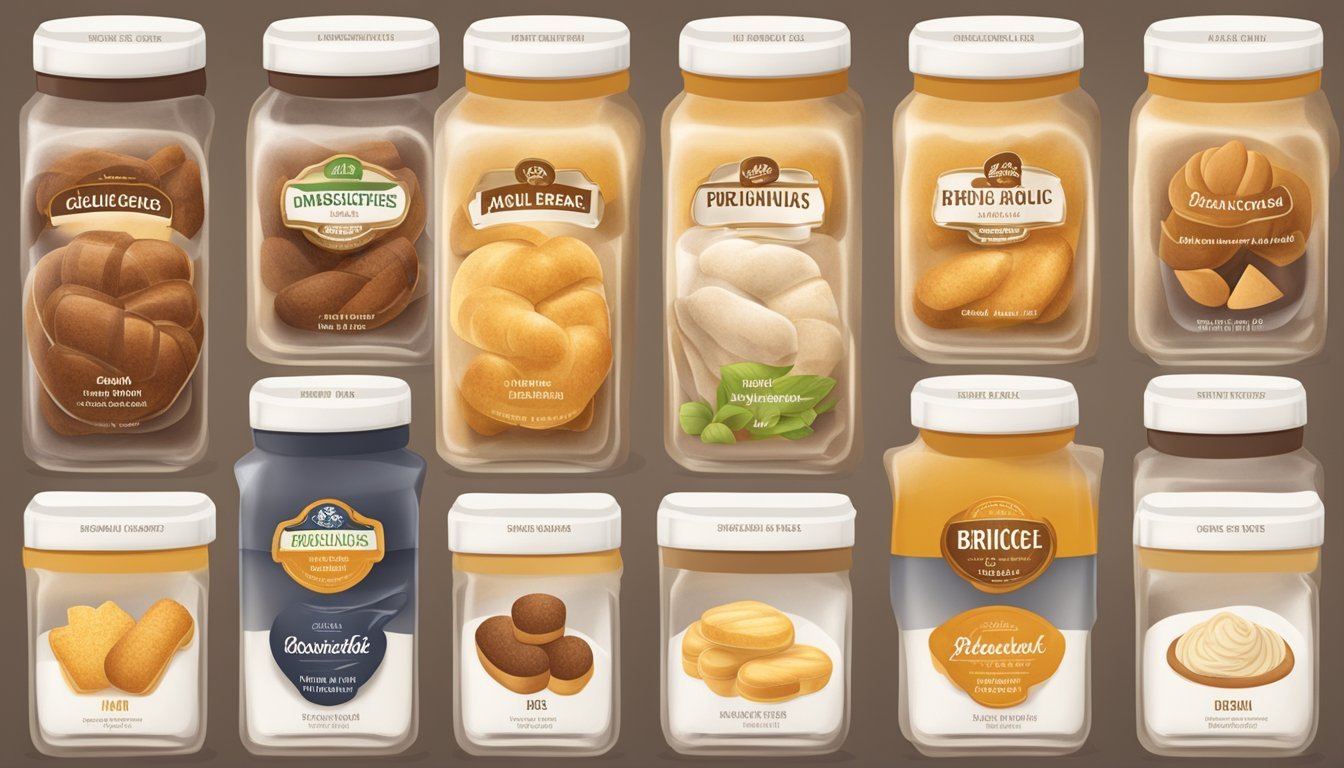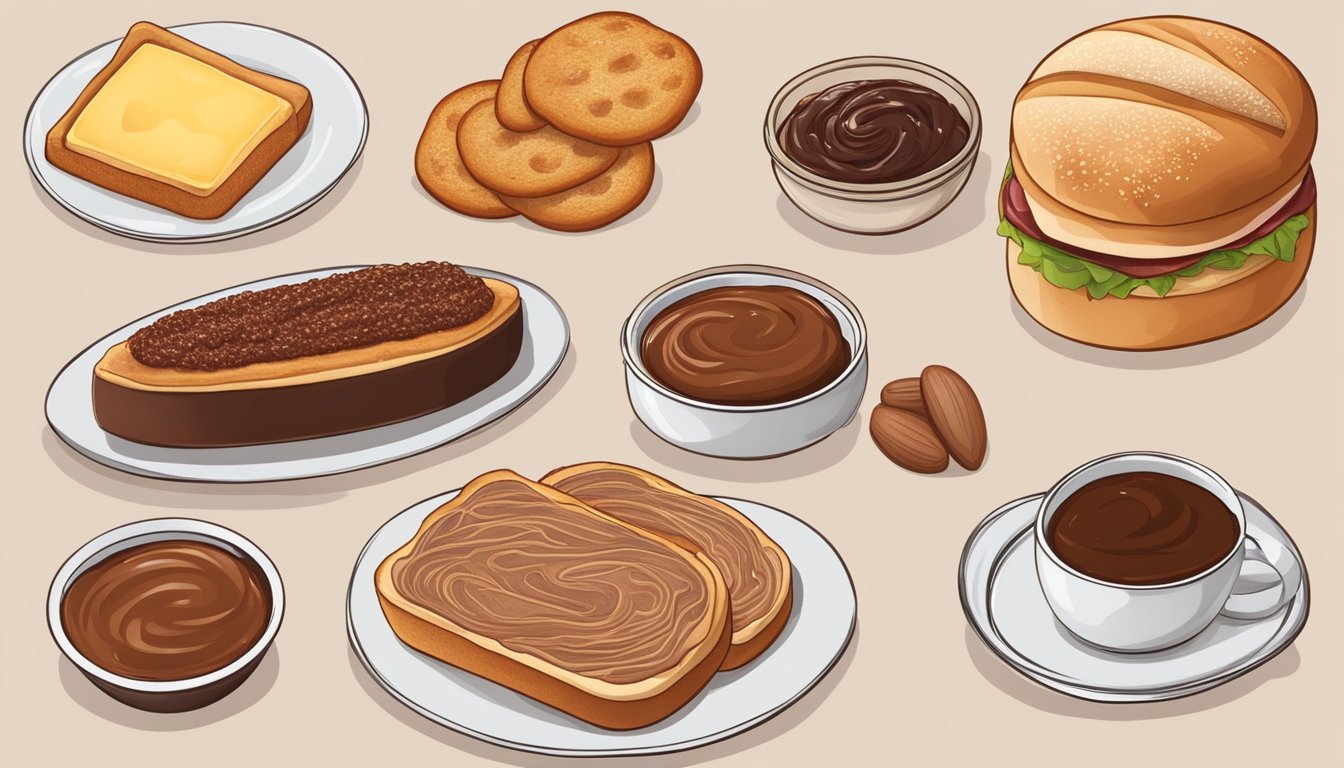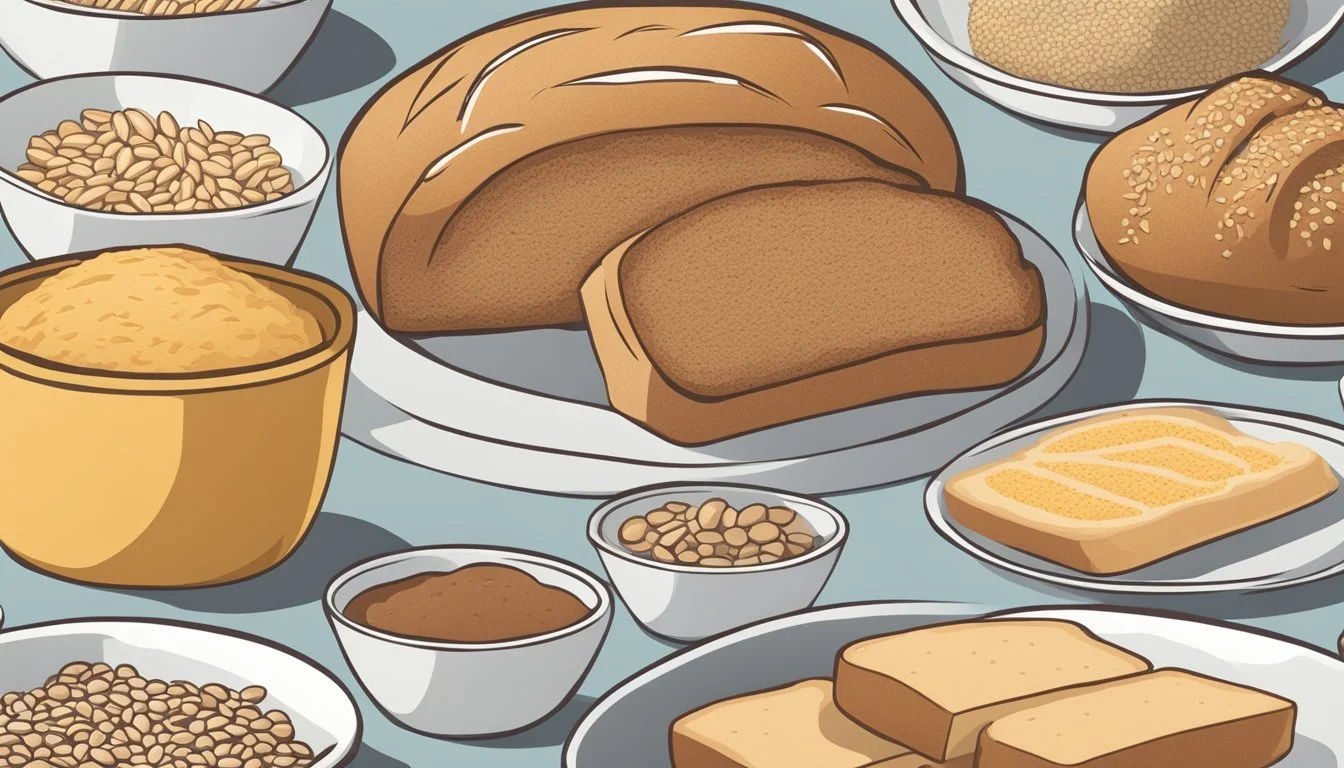Brioche Bread Substitutes
Top Alternatives for Your Recipes
Brioche bread, with its rich and tender crumb, is a beloved staple in many cuisines. Its distinctive taste and texture come from a high content of eggs and butter, which not only adds flavor but also yields a soft, pillowy loaf. Recognized for its versatility, brioche plays a starring role in both sweet and savory dishes, from decadent French toast to gourmet sandwiches (What wine goes well with sandwiches?).
However, despite its popularity, there are occasions when brioche is unavailable or diners are seeking an alternative with a different nutritional profile or flavor. In these instances, it's helpful to have a selection of substitutes that can mimic brioche's characteristics to some extent. Various breads such as challah, which is similarly enriched with eggs and butter, along with other options like Japanese milk bread, known as shokupan, or the less rich but still tender Pullman loaf, can serve as satisfactory replacements.
Culinary enthusiasts and casual cooks alike may delight in experimenting with these alternatives, as each brings its own unique qualities to the table. While no substitute will be an exact replica of brioche's distinctiveness, the right choice can complement a dish in much the same way, allowing for a seamless culinary experience.
Understanding Brioche Bread
Brioche bread is a type of French pastry that is rich in flavor and soft in texture, making it a versatile component in both savory and sweet culinary applications.
Characteristics of Brioche
Ingredients: The primary ingredients of brioche include:
Flour: Provides the structure.
Eggs: Rich in proteins, adding to the richness and color.
Butter: Contributes to the tender crumb and rich flavor.
Sugar: Adds a subtle sweetness.
Milk: Often included to enhance the bread's tenderness and flavor.
Texture and Taste: Brioche is distinguished by its soft and pillowy texture attributable to the high content of eggs and butter. It has a delicate, slightly sweet flavor which is balanced by the bread's buttery richness. Brioche dough is typically given a long and slow fermentation period, which not only contributes to its unique taste but also to its fine, feathery texture.
Popular Uses of Brioche
French Toast: Brioche bread is well-suited for French toast due to its ability to soak up the egg and milk mixture without falling apart.
Sandwiches: Its sturdy yet soft texture makes it a favorite for gourmet sandwiches.
Burgers: Brioche buns have become a popular choice for burgers, both for their taste and their ability to hold up well under juicy patties.
Bread Pudding: Its rich texture makes it an ideal choice for a luxurious bread pudding.
Dessert Applications: Brioche can be used in a variety of desserts, where its buttery and slightly sweet profile adds depth to the flavor of the final dish.
Brioche Bread Alternatives
When seeking alternatives to brioche bread, one should consider the substitute's texture and taste to ensure it complements the intended dish. The aim is to find bread that can provide a similar richness or desired consistency, whether it is for French toast or burgers.
Substitutes Based on Texture
For those who prioritize the texture of brioche -- soft, fluffy, and with a tender crumb -- several options stand out. Challah bread offers a comparable consistency, with its braided shape contributing an artisanal touch. Japanese Shokupan, or milk bread, is another fluffy bread with a bouncy texture, though less rich than brioche. For something with more body but still airy, the Pullman loaf might serve as an adequate stand-in, especially for sandwiches or toast.
Substitutes Based on Taste
If the sweet and buttery flavor profile of brioche is crucial, alternatives like Hawaiian rolls and croissants are excellent options. These substitutes contain similar levels of sugar and butter, achieving a delectable taste that closely mirrors that of brioche. For those desiring a less pronounced sweetness, potato rolls may provide a subtly sweet and flavorful alternative suitable for various culinary applications.
Substitutes for Specific Recipes
Some recipes that traditionally use brioche bread might require specific considerations in a substitute. For French toast and bread pudding, challah and croissants can be used without much alteration to the expected flavor or texture. In the context of burgers and sandwiches, Potato rolls can be a reliable substitute for brioche buns due to their similar soft yet sturdy structure, ensuring they hold up well against various fillings and sauces. When making a lighter option like a sandwich, white breads such as the Pullman loaf offer a practical yet delicious alternative.
Healthier Substitutes
When considering substitutions for brioche bread with a focus on health, options that are lower in calories and fat, as well as those that cater to gluten-free and vegan diets, can be beneficial.
Reducing Calories and Fat
To reduce calories and fat content, one could opt for whole wheat brioche. Whole wheat flour adds fiber and nutrients without the high caloric content of traditional brioche made with refined white flour. A homemade brioche variation using margarine instead of butter can lower the saturated fat content, although it's essential to select a margarine with no trans fats.
For those looking for store-bought alternatives, choosing simple bread types such as:
Multigrain
Rye
Sourdough
can also help in managing overall caloric intake. Each of these breads is typically less dense in calories compared to the rich and tender brioche.
Gluten-Free and Vegan Options
For those on gluten-free diets, gluten-free bread options are widely available. They typically use a blend of rice flour, tapioca flour, and sometimes potato starch to mimic the texture of wheat-based breads. When seeking a healthier version of brioche that is both gluten-free and vegan, one should look for products that are:
Ingredients Health Benefit Almond flour Higher protein and nutrient-rich Flaxseeds Omega-3 fatty acids and fiber
Vegan bread typically substitutes eggs and dairy with plant-based alternatives such as almond milk and flax eggs. These substitutions not only cater to dietary restrictions but also contribute to a heart-healthier profile, suitable for those looking to reduce cholesterol intake.
Homemade Brioche Alternatives
Creating homemade brioche alternatives involves tweaking the classic recipe or incorporating different types of flour. This section covers specific variations to the brioche dough and introduces the use of alternative flours to achieve a brioche-like texture and flavor.
Brioche Dough Variations
Ingredients:
Flour: 4 cups
Sugar: 2 tablespoons
Salt: 1 teaspoon
Yeast: 1 packet (2 1/4 teaspoons)
Milk: 1 cup, warmed
Eggs: 4, large
Unsalted butter: 1/2 cup, softened
Method:
One can alter the classic brioche recipe to create a slightly different but equally rich and tender bread. For instance:
Reducing Butter: Use only 1/4 cup of softened unsalted butter instead of the usual 1/2 to 3/4 cups to decrease fat content while maintaining a tender crumb.
Egg Variations: Decrease eggs to three for a less rich dough or substitute one of the eggs with two egg whites to lighten the texture.
Using Different Flours
Substituting different types of flour can significantly alter the final product's texture and taste, leading to a unique homemade brioche bread variation.
White Flour: For an authentic brioche, use high-quality white flour to achieve the classic, tender crumb.
Whole Wheat Flour: For a healthier twist, one can replace half of the white flour with whole wheat flour. This will result in a denser, nuttier bread, while still retaining some brioche-like qualities.
Flour Type White Flour Whole Wheat Flour Texture Light Dense Flavor Profile Mild Nutty Recommended Use Classic brioche recipe Healthier brioche variations
Note: When using whole wheat flour, one may need to adjust the hydration of the dough, as whole wheat flour absorbs more liquid than white flour.
Global Brioche Variants
When exploring brioche bread substitutes, one can find an impressive array of global variants influenced by French, Italian, German, and Asian baking traditions. Each brings its own unique characteristics to the table, often embodying a balance of fluffy texture and subtle sweetness.
French Influenced Bread
French baking techniques have led to the creation of several breads akin to brioche. Pain de mie is a French staple, similar to the American Pullman loaf, known for its fine, light crumb, making it suitable for sandwiches and French toast. On the sweeter side, French bread varieties like panettone and kugelhopf have a cake-like quality. They are often used in rich desserts similar to bread pudding due to their airy and sweet characteristics.
Italian and German Influences
Moving towards Italian and German influences, ciabatta emerges as an Italian bread with a crusty exterior and porous texture, although not as sweet as brioche. Challah, a Jewish bread with roots in various European traditions, presents a slightly sweet taste and a tender crumb, ideal for absorbing custards in French toast or pudding recipes. Panettone, an Italian Christmas bread, is rich with dried fruits and has a sweet, light, and fluffy dough that comes close to the brioche texture.
Asian-Inspired Substitutes
Asian bakeries offer their own brioche-like specialties. Japanese milk bread, or shokupan, is exceptionally soft, fluffy, and mildly sweet, often used as a substitute for brioche in both savory and sweet applications. Another Asian variety, pai bao, offers a similar flavor profile with a delicate, pillowy texture, which makes it a viable option for those looking to replicate the brioche experience in dishes such as French toast.
Sweet and Savory Combinations
Brioche bread, with its rich buttery flavor and slightly sweet profile, pairs excellently with both sweet and savory elements. In the exploration of combinations, one will find that the versatility of brioche stands out, whether used in sandwiches with meats and cheeses or as a base for desserts with sweet spreads and custards.
Pairing with Fruits and Meats
Sandwiches: Brioche elevates the common sandwich with its rich texture. For savory options, ham often makes an excellent pairing:
Classic Ham & Brioche: Thinly sliced ham on brioche, complemented by a hint of sweetness from pineapple juice or a slice of pineapple for a tropical twist.
Brioche Burgers: A brioche bun provides a sturdy and flavorful base for burgers, balancing out the savory meat with its subtle sweetness.
Sweet Bread Concoctions: Brioche's tender crumb is compatible with a variety of meats and fruits:
Hawaiian Sweet Bread Twist: Similar to Portuguese sweet bread, substitute with brioche and add a layer of ham for a comforting, sweet and savory treat.
Fruit-Filled Bites: Combine brioche with fruit preserves, or fresh fruits like strawberries, and pair with creamy elements like custard or cream for a delightful contrast.
Sweet Spreads and Fillings
Custards and Creams: Brioche acts as a sponge for rich, creamy fillings, yielding indulgent results:
Custard Soak: Brioche slices soaked in a mixture of custard blend well with sugar and cream, revealing a satisfying dessert experience.
Chocolate Decadence: Spread a thick layer of melted chocolate on brioche for an irresistibly rich and luscious treat.
Sweet Spreads: The bread's sweetness complements an array of spreads:
Classic Sugar & Spice: A sprinkle of sugar with cinnamon on lightly toasted brioche slices makes a simple yet enticing snack.
Indulgent Chocolate Spread: For a quick, sweet bite, slather a generous helping of chocolate spread on brioche, creating a perfect harmony of flavors.
Creative Culinary Uses
While brioche bread is a well-loved ingredient in both sweet and savoury dishes, there are a myriad of substitutes that can be employed to bring a similar rich, delectable quality to various meals. With a focus on texture and flavor, these alternatives can be used innovatively across an array of recipes.
Alternative Bread in Meals
When brioche is not on hand, some Pullman bread, also known as a sandwich loaf, can fill its place in numerous recipes. It’s a suitable choice for a plush yet firm texture in sandwiches. For a French toast that is less dense but still delightful, Pullman bread absorbs the egg and milk mixture efficiently, giving it a tender, custardy interior once cooked.
Substitution in Dinner Recipes:
Brioche Original Use Substitute Bread Consideration Brioche bun for burgers or sliders Pullman loaf or Challah Consider a light toasting to improve structure. Savarin in savory applications Sweet white bread May need to adjust for sweetness level.
Desserts and Sweet Treats
For dessert offerings such as bread pudding, a dense, sweet Hawaiian roll can replace brioche to layer the dish with a tropical hint while maintaining the expected custardy texture. Brioche imparts a sumptuous richness to sweet applications, which a lightly sweetened white bread or Challah can approximate.
Substitution in Sweet Dishes:
Bread Pudding: A brioche alternative like Hawaiian rolls or Challah - tear into pieces and soak in the custard mixture.
Pudding: Use cubed Pullman loaf or sweet white bread as the base; it will provide a light yet satisfying cohesiveness to the dish.
Savarin: This ring-shaped dessert can also be crafted with a sweet white bread; make sure to thoroughly soak it in syrup.
Storing and Reviving Brioche Bread
Proper storage can significantly extend the life of brioche bread, while effective revival techniques can rejuvenate bread that has gone stale. These methods ensure that the delightful taste and texture of brioche are maintained as long as possible.
Long-Term Storage Tips
To preserve the quality of freshly baked brioche or a leftover baguette, one should adhere to the following storage tips:
Room Temperature Storage: Store brioche in a cool, dry place inside a bread box or wrapped in a cloth to maintain freshness for up to 2-3 days.
For optimal long-term storage, slice the brioche and wrap individual portions tightly in cling film or foil.
Place wrapped slices in a freezer bag, expelling as much air as possible before sealing.
Label the bag with the date, and store in the freezer for up to one month.
Refreshing Stale Brioche
Reviving stale bread includes:
In the Oven:
Preheat the oven to 300°F (150°C).
Lightly dampen the crust of the brioche with water. Wrap it in foil to prevent burning.
Heat for approximately 5-7 minutes or until warmed through and the crust is crisp.
For Bread Pudding and Other Recipes:
Cube stale brioche or leftover baguettes.
Use these cubes as a base for savory or sweet dishes like bread pudding.
Enhance the flavor with spices such as cinnamon to revive the bread in delightful ways.
Nutritional Information and Benefits
When considering substitutes for brioche bread, it is important to assess the nutritional content as well as any associated health benefits. This section examines how different breads compare in terms of calories and provides insight into understanding bread labeling.
Caloric Content Comparison
The caloric content of bread contributes significantly to one’s daily dietary energy intake. Brioche, known for its rich flavor, is typically high in calories due to its generous use of eggs and butter. In comparison, substitutes like whole wheat bread or Pullman loaf may offer fewer calories. Below is a simplified table comparing the estimated caloric content per average slice of brioche bread and its common substitutes:
Type of Bread Estimated Calories per Slice Brioche Bread 130-150 Whole Wheat Bread 70-90 Pullman Loaf 80-100 Challah Bread 100-120 Shokupan 120-140
Understanding Bread Labelling
Consumers seeking healthier versions of their favorite foods must become adept at interpreting nutrition labels. Nutrition labels on bread can provide a wealth of information including calorie content, grams of fat, carbohydrate levels, and protein. Most importantly for those considering alternatives to brioche, labels can indicate the presence of whole wheat flour, which brings a higher fiber content and associated health benefits compared to refined flours. It's essential to note that terms like "multigrain" or "wheat" do not always equate to whole grain, therefore, one should look for labels that specify "100% whole wheat" to ensure they are getting a product made from whole wheat flour.










